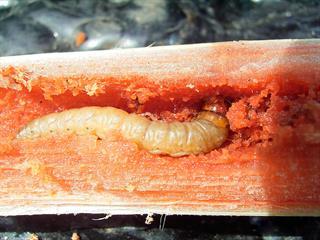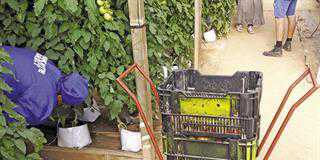
Several initiatives to control insect pests using nuclear techniques are entering an advanced stage in South Africa. According to the International Atomic Energy Agency (IAEA), the research offers the possibility of controlling the major sugarcane pest, Eldana saccharina, as well as mosquitoes of the Anopheles genus that spread malaria.
Eldana has been a major problem for SA sugarcane production since the 1970s. Adult female moths lay eggs on dead sugarcane leaves. When the eggs hatch, the larvae burrow into the sugarcane stalks and begin feeding on the soft tissue within. Eldana infestation severely degrades the quality and yield of sugarcane harvests.
The current damage caused by Eldana is estimated at R750 million a year, according to the IAEA. This is close to 10% of the total income of South Africa’s sugarcane-growing sector, which comprises about 22 000 farmers, from smallholders to large commercial plantations.
Low doses of radiation are used to sterilise captive adult male insects. These are then released into the wild to mate with female moths, resultiing in unfertile eggs, explains Des Conlong, a senior entomologist at the South African Sugarcane Research Institute (SASRI) and manager of its Eldana sterile insect technique (SIT) project.
This form of ‘insect birth control’, in combination with thorough orchard sanitation, has already successfully suppressed the false codling moth (Thaumatotibia leucotreta) in the Olifants River Valley orchards of the Western Cape. “We’re working to develop a similar solution against Eldana in sugarcane,” says Conlong.
Over the decades, SASRI has developed several techniques to control Eldana infestations. These include Eldana-resistant sugarcane varieties, chemical spray programmes, and the use of parasitoids.
Integrated management
Applied across large areas as part of an integrated pest management programme, the SIT can significantly suppress and, in some cases, eventually eradicate wild populations of targeted insect pests. According to IAEA, the technique is considered by many to be among the most environmentally-friendly insect pest control options available.
It is also the only pest control technique that becomes cheaper as its effects take hold, adds Conlong. This is an important consideration, as many smallholder sugarcane farmers find the cost of chemicals to control Eldana prohibitively expensive.
Also, many parasitoids that prey on Eldana do not flourish in the sugarcane habitat. With Conlong and his team having shown that male Eldana moths can be sterilised without compromising their ability to mate in the wild, SASRI is increasing production of sexually competitive Eldana adults at its rearing facility.
The next stage will involve a pilot in-field trial on an isolated, 5ha Eldana-infested sugarcane plantation in KwaZulu-Natal. It currently costs approximately R20 million to buy and install the irradiator required for the SIT to be implemented in the trial.
“The past few years have been tough for the SA sugar industry due to the prolonged drought, so funding for the project has been postponed,” says Conlong. “The SA government, however, is ready to fund part of the costs to buy an irradiator for the programme.”
In addition, SASRI intends to join forces with the National Institute for Communicable Diseases (NICD) to use the SIT to further suppress and possibly even eradicate malaria in South Africa.
Fighting malaria
Malaria remains a serious health problem in the north-eastern parts of the country. Widespread chemical spraying and other measures to control the mosquitoes have had significant success over the decades, but pockets of these pests remain.
While malaria cases in the country have dropped from more than 60 000 annually to the current 9 000, approximately 10% of South Africans still live in the areas plagued by malaria-carrying Anopheles mosquitoes, according to the IAEA.
“The problem is that the Anopheles mosquito rests both indoors and outdoors. So even if all Anopheles mosquitoes were eradicated indoors, those resting outside would survive and continue to spread malaria,” says Lizette Koekemoer, who heads the NICD project to further reduce malaria infections in South Africa.
With the support of the IAEA, the NICD has been researching the application of the SIT for the control of the Anopheles mosquito for the past five years.
The IAEA has provided the NICD with mass-rearing equipment for the mosquitoes and, in co-operation with the FAO, trained NICD researchers in its laboratories in Austria in the techniques of insect rearing, feeding and sterilisation through irradiation. This has enabled the NICD team to learn from other initiatives in customising the SIT for Anopheles control, says Koekemoer.
“It has helped us move through the phases of the research much more rapidly than if we had to do this by ourselves from scratch.”
The NICD has been able to determine the quantity of radiation required to sterilise male mosquitoes without compromising their sexual competitiveness and is now seeking a suitable way to separate male from female mosquitoes. This separation of the mosquito sexes is crucial, says Givemore Munhenga, a senior researcher with the NICD project.
“It’s the females that spread malaria and mass-releasing only sterilised male Anopheles mosquitoes eliminates any risk of increasing the number of mosquitoes carrying the malaria parasite. Female mosquitoes must be removed from any groups that are released,” he explains.
In collaboration with South Africa’s Nuclear Technologies in Medicine and the Biosciences Initiative, the NICD has secured funding to build a pilot mass-rearing facility for Anopheles mosquitoes near Johannesburg. The sterilised males will then be released in a pilot project in a small village in northern KwaZulu-Natal.
- Contact SASRI on 031 508 7400 or [email protected]. Visit sasa.org.za.
- Contact the NICD on 011 386 6000 or [email protected]. Visit nicd.ac.za.
- Visit the IAEA website at www.iaea.org.












